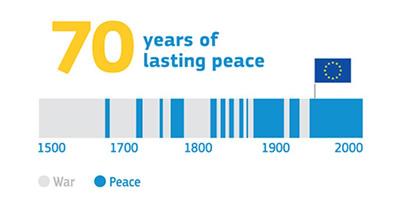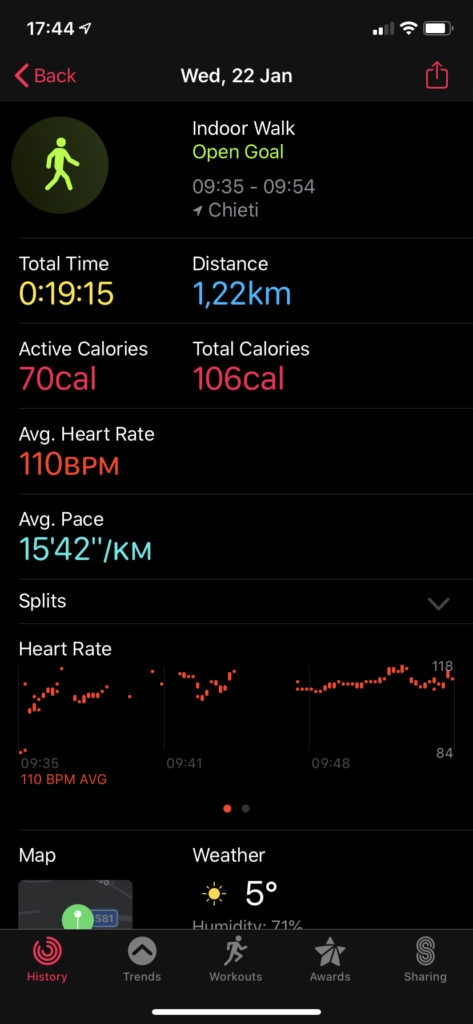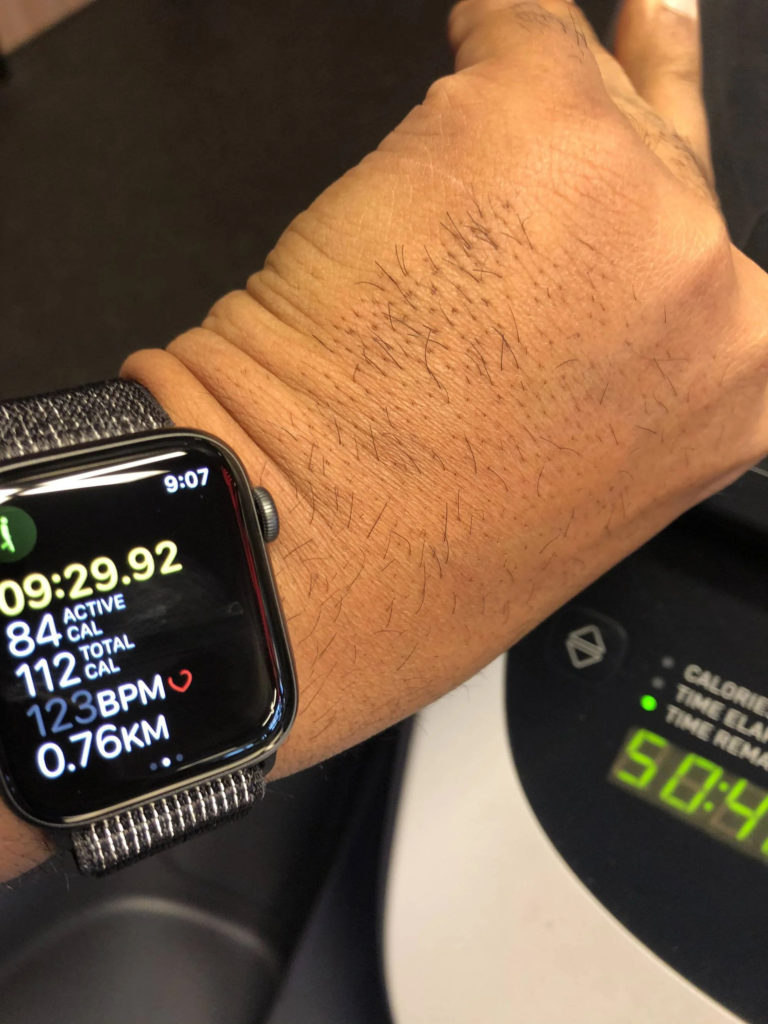As promised on Facebook (for the few who follow me there), here’s a look at the latest numbers coming from Italy about Covid19.
Those numbers are being used as a reference in many countries to warn people: look at how badly Italy is doing! And yes, it’s a mess, but not for the reasons that may seem obvious at a glance. Numbers mean nothing without some context, and that’s what I’ll try to provide here. Keep in mind that I’m not a statistician and this is all my own work, so any mistakes you may find are to be blamed exclusively on me.
First of all, this table in the official GitHub repository by the Prime Minister’s Office is updated daily, so it’s worth a bookmark. The field names are in Italian, so for those who don’t speak the language:
| data |
date (Italian time zone) |
| stato |
country (always ITA) |
| ricoverati_con_sintomi |
hospitalized with symptoms |
| terapia_intensiva |
in intensive care |
| totale_ospedalizzati |
total hospitalized |
| isolamento_domiciliare |
isolated at home (under medical surveillance) |
| totale_attualmente_positivi |
current total positives |
| nuovi_attualmente_positivi |
new total positives (compared to yesterday) |
| dimessi_guariti |
discharged and recovered |
| deceduti |
deceased |
| totale_casi |
total cases |
| tamponi |
tests |
Let’s first look at what we have. At the time of writing this, the latest data is from 21 March. There’s a handy table for that, further split by Region. We’ll only look at the bottom line, which looks at the country as a whole.
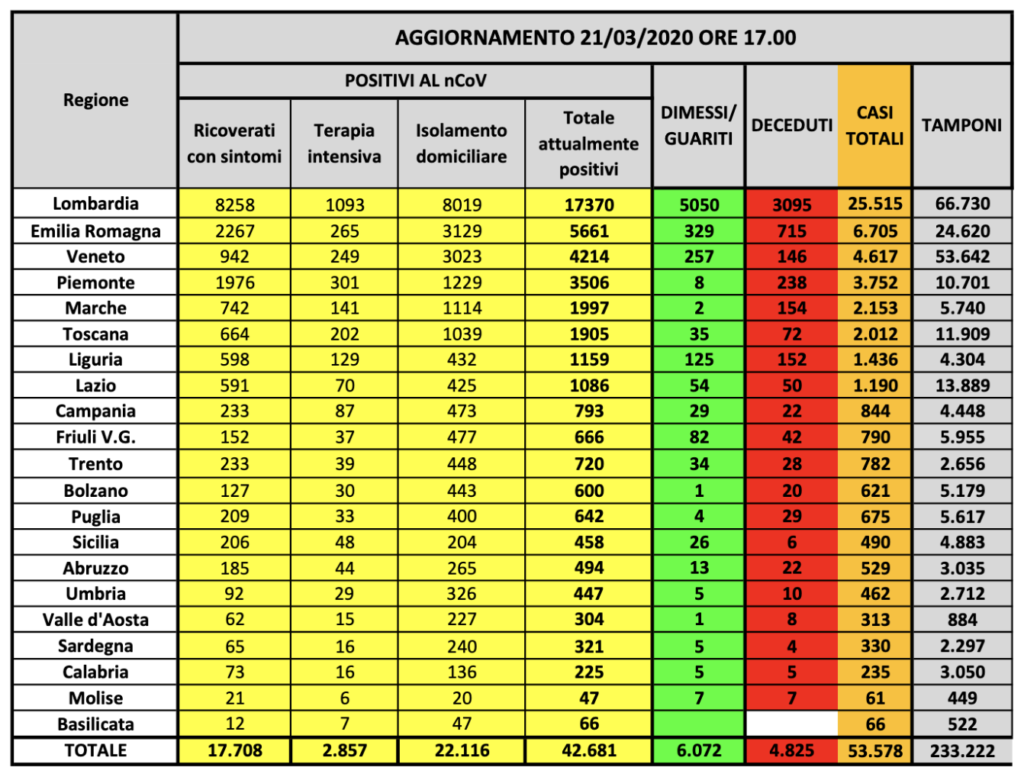
- The number of active cases is 42,681, of which:
- 22,116 (~51.8%) are isolated at home, likely because they show mild or no symptoms
- 20,565 (~48.2%) are hospitalized, of which:
- 17,708 (~86.1%) are not in intensive care, likely because they show mild or non-life-threatening symptoms
- 2,857 (~13.9%) are in intensive care
What the data doesn’t immediately say is that 6.6% of current registered cases (2,857 out of 42,681) is currently in intensive care, while the 93.4% does not require that. We clearly cannot tell how many currently in intensive care will die, or how many will worsen to the point of needing intensive care.
Let me put that another way: over 9 out of 10 registered cases are not in intensive care, and indeed half of them are not even hospitalized. Of those who are, about 1 out of 7 requires intensive care; if that’s scary, flip it into hope: 6 out of 7 people hospitalized do not need intensive care.
The total number of registered cases is 53,578, meaning that 10,897 cases are “closed”. Out of those, 6,072 recovered and 4,825 died. That is admittedly scary, and this is the part where people generally get upset, because it seems insensitive. So, before I even present some data, let me preface that by saying that I mean no disrespect to anyone, and that I have many relatives (including my parents) who are approaching the demographics I’ll discuss, so of course I am personally worried. With that disclaimer, let’s look at the numbers.
The National Health Institute keeps daily statistics here, another page worth bookmarking. The latest infographics shows that the average patient age is 63, with 36.2% of all cases being over 70 and 37.5% being between 51 and 70. Let’s flip the numbers again to get a better picture: confirmed patients of any age between 0 and 50 are 26.3%, while cases over 50 are 73.7%. That’s three times as much. And before we look at what that means, let’s throw in some other numbers: the extended report, last published 3 days ago, shows that the percentage of deaths by age group is less than 1% for each range up to 40-49, increases slightly to 2.7% for ages 50-59, grows to 10.2% for ages 60-69, then jumps to 35.8% for ages 70-79 and becomes a whopping 40.8% for ages 80-89. It then decreases to 9.4 for people over 90+, most likely because there aren’t as many people that old to begin with.
Before we make sense of all those numbers, let’s look at the general demographics of Italy. We only really need one dataset, that is the population pyramid. This is from the UN’s World Population Prospects:
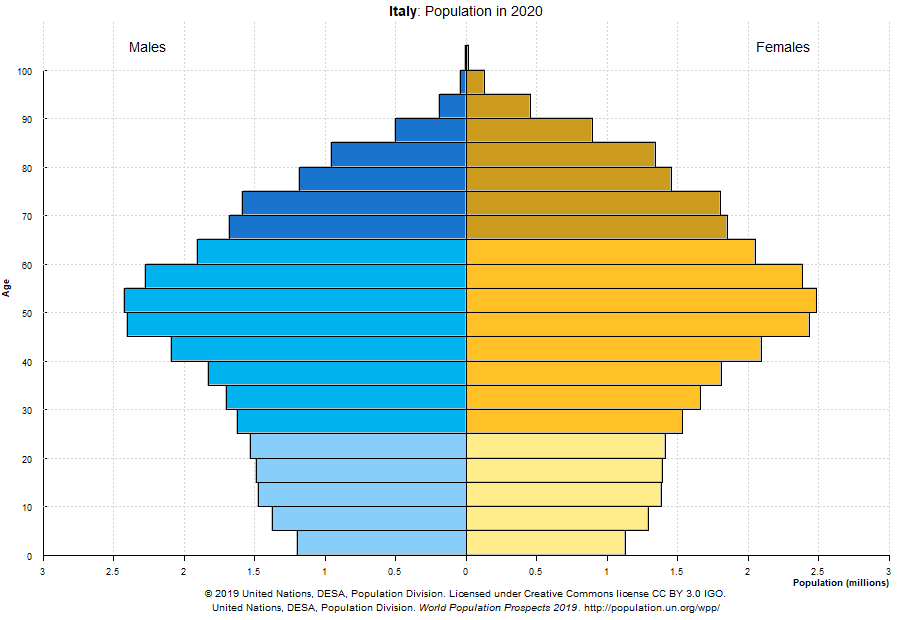
The median age in Italy is 47.3 years, but that alone doesn’t say much. You really need this graph to realize that there are more elderly people than young people. Italy is pretty old, and Covid19 attacks older people more easily. That is one of the reasons why our numbers are so high: it’s simply more likely for our aging population to be affected, and older people are also more likely to have pre-existing medical conditions — technically called “comorbidities” — that are exacerbated by Covid19 and ultimately lead to death.
If that weren’t enough, there are also some social and cultural factors coming into play: the “sense of family” is pretty strong here, and many people here live with their parents until they’re in their 30s or even later. Even if they don’t, family gatherings are a common ritual, so there’s a lot of inter-generational mingling. Other countries may have a more “compartmentalized” society, which may help reduce the risk of infection across different age groups.
One last factor complicating the Italian situation doesn’t affect just the numbers themselves, but also all the percentages being thrown around. Many people who test positive to the virus are completely asymptomatic, and testing centers across the country are already at capacity. As a consequence, in many areas only people with serious symptoms are tested, in order to move them to the newly created “Covid hospitals” (i.e. hospitals or parts thereof that have been dedicated exclusively to Covid19 patients, in order to aid in containment). Many people with mild symptoms are being told to isolate at home under medical surveillance, but are not counted as positive, simply because they are not tested unless necessary. Furthermore, it’s unclear how many people are dying at home from Covid19 complications, and those are not officially counted among the infected either, for the same reason: they were never tested.
Note that I said “many areas”. That’s because the healthcare system in Italy is run independently by each Region, so the choice on whom to test varies in each location. The decision is usually based on how dire the situation is, how many testing labs are available nearby, and ultimately how much money is available. As a side note, and I’ve said this before, it’s almost a blessing in disguise that the worst affected areas are in the north; had the epidemics started in the chronically underfunded south, things would be way, way worse.
Still, the net result of all this is that the numbers you see are making less and less sense as we go forward. Ultimately, we have no clear idea how many people are effectively infected, with some estimates saying that for each confirmed case there are at least five unconfirmed ones; we don’t know how many people are dying from Covid19 complications, because some may die before being tested; and, consequently, the mortality rate is also meaningless, since both the numerator (deaths) and denominator (infections) are unreliable.
So, is it just total mayhem? Sort of. As someone who’s living through this on a daily basis, I think that the best thing we can do, and I believe that this should be the case in other countries as well, is not to focus on the numbers. I know it sounds like borderline blasphemy, but hear me out. We saw this above: even in an old country like Italy, over half of all confirmed patients have symptoms so mild that they just ought to stay at home, and out of the other half that’s hospitalized, 86% is not in intensive care. And most of those who are more seriously affected and die are either older people, or those with serious pre-existing conditions. Once again, I am not dismissing that are mere statistics, and I’m well aware that each unit in those numbers is actually a personal tragedy and a broken family; really, I am not dismissing that in the slightest, but I think it’s important to look at the bigger picture if we want to get through this without going crazy.
The combination of being locked inside and being constantly exposed to growing numbers, especially as those numbers are thrown around by the media without absolutely any context or explanation, are freaking people out. It’s probably hard to explain to non-Italians right now, but it will start happening elsewhere as well. You can’t leave the house unless you have a valid reason due to the pandemic (something that’s been abused so much by some people that last night the government tightened that requirement even further), and all you hear about the pandemic is how every day more and more people are catching and dying from it.
It’s not just the evening news on TV, it’s the online news as well, that you can read in real time whenever you want; it’s the Google alerts, it’s the posts on Facebook, the tweets, the group chats and chains on WhatsApp. Italians in particular were hit like a freight train by the social media revolution in the last few years, but were not prepared for it. Most people simply fall for clickbait and fake news, often spreading it further in good faith. Even I struggle to make sense of all this, despite being quite well versed into reading through the lines and not taking raw numbers at face value, and with over six years of experience as a search engine evaluator. I find myself reassuring my parents that things are not as bad as the numbers suggest, and urging them not to fixate on the numbers they hear on TV, or the absurd titles such as “It’s a global war”. Is it really surprising that people feel hopeless?
Just yesterday I had to help a relative through figuring out whether an “call for action” she had gotten from a contact via WhatsApp was real or not, and it took me over 40 minutes of sifting through web pages to tell her what to do; and again, I’m someone who evaluates web pages for a living, and who’s been online for the last 24 years, long before Google even existed. Most people have no such tools or skills, get overwhelmed by all they hear, have no idea whom to believe, and either get depressed, or panic, or both. And they can’t be blamed.
But, once again, and this is for all my foreign friends who keep reading those numbers with even less context on their own national media: take them with a grain of salt and keep in mind that there’s always more to things than raw figures. Don’t let that freak you out. The situation is serious, and it will likely get serious in other countries as well. There’s no point in hiding that. But rest assured that, as bad as it is in some areas, this is not the apocalypse. There are no corpses piled up in the street, there is no shortage of groceries, and most people at home are simply bored at this point.
Do your part to prevent this thing from spreading. That’s the best thing you can do. You’ve heard this a million times but I’ll give a quick recap:
- stay at least one meter / three feet away from others, even if you share an apartment… you can never be too careful
- don’t go out unless absolutely necessary and always following your local regulations
- wash your hands regularly and thoroughly with soap, or use hand sanitizer as an alternative
- don’t touch your face unless you’ve just washed your hands
- only wear a mask if you are showing symptoms, otherwise it’s useless or even counterproductive
- keep in mind that the virus is not airborne
- in case you develop symptoms, follow your local regulations on what to do; as a rule of thumb, call your doctor (don’t just go!)
- when buying groceries, buy a little more than you normally would but for the love of all that’s holy, do not hoard anything! doing so simply prevents others from getting their fair share of things and is causing more trouble than the virus itself
And, if I may add one personal suggestion: stay away from social media and from the news, or at least don’t spend too much time on them. It changes absolutely nothing about what’s going on, yet it alters your perception and fuels the sense of gloom and doom and impending armageddon, and that’s really the one thing we should avoid. Mass hysteria never led to anything good. Things will get worse before they get better, but — and this is the one key takeaway — the more we stick to doing our part, the sooner that will happen. That’s really all there is to it. We’re in this together.
On a lighter note, the forced lockdown is pushing many social gathering to become streaming events, and that includes religious functions. However, not everyone is completely at ease with technology yet. For instance, this catholic priest accidentally celebrated his Sunday mass with face filters on, and the result is quite amusing…
